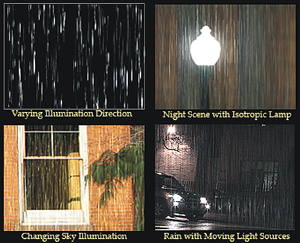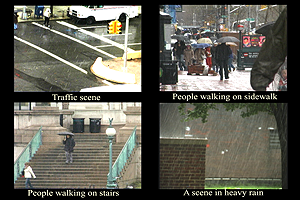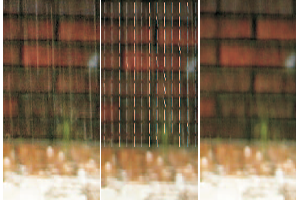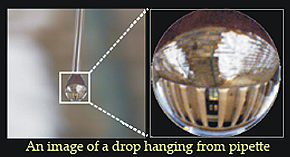
Kshitiz Garg
Former PHD Student
Vision LabComputer Science Department
Columbia University
Office: 616 CEPSR
Phone: 212-939-7090
Fax: 212-666-0140
kshitiz_at_cs.columbia.edu
 |
Kshitiz GargFormer PHD StudentVision LabComputer Science Department Columbia University Office: 616 CEPSR Phone: 212-939-7090 Fax: 212-666-0140 kshitiz_at_cs.columbia.edu |
| My research |
I graduated on May of 2007 and am currently working in a
startup company in Boston area. My earlier research (during doctoral days)
focused on improving outdoor vision in bad weather such as rain and snow. Rain
and snow create sharp intensity fluctuations in images and videos, which degrade
the performance of many outdoor vision algorithms such as feature tracking,
segmentation, object recognition and tracking. My thesis work focused on handing
rain. The main goal was to understand the visual effects produced by rain and
develop models that lead to simple and effective algorithms for handling rain in
images and videos and for its photorealistic rendering in graphics.
| Recent publications |
|
|
Splashing of water drops is one of the visually fascinating phenomena
and capturing their interaction with scene elements is important in
achieving realism. Splashing results from complex interactions between the
drop and the material it impacts, which makes it hard to model
analytically. This work takes an empirical approach. We measure the
splashing behaviors of 22 common real word material and use it to develop
a stochastic model for splash distribution. Our model is built upon
empirical models previously developed in fluid dynamics and meteorology
and only requires few parameters for generating splashes. User can tune
the parameters to create novel splashes or combine different materials to
generate physically plausible splashes for novel materials. The model is
applicable for rendering splashes due to rain as well as water drops
falling from large heights such as windowsills, trees, and rooftops. |
 |
[PDF] [Project Page] [Implemented in Microsoft SDK 10] (search topic rain ) |
||
 |
[PDF] [Project Page] |
 |
[PDF] [Project Page] |
||
 |
[PDF] [demo] |